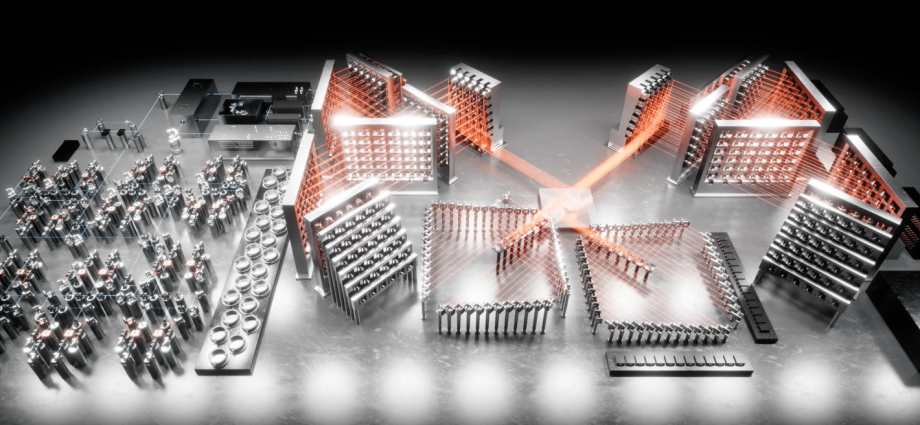Chinese scientists unveiled a new light-based quantum computer, which broke the world’s speed record in terms of the number of “detected photons.”
Jiuzhang 3.0, developed by a team led by Chinese physicist Pan Jianwei, has 255 detected photons, compared with 113 achieved by Jiuzhang 2.0 and 76 by the original Jiazhang quantum computer.
Chinese state media said Jiuzhang 3.0 is a million times faster than Jinzhang 2.0 at solving Gaussian boson sampling problems, a mathematical model suitable for quantum computation.
They said Jiuzhang 3.0 can calculate the most complex samples of Gaussian boson sampling in one microsecond while the world’s fastest supercomputer “Frontier” would need more than 20 billion years to complete the task.
The study made by Pan’s team was published online in the Physical Review Letters, an American scientific journal, on Wednesday.
“Quantum computers have ultra-fast parallel computing capabilities in principle, and are expected to provide stronger computing power support than traditional computers through specific algorithms in areas such as code deciphering, big data optimization, weather forecasting, material design and drug analysis.” Pan Jianwei said.
Xanadu, a Toronto-based company, said in June last year that its quantum computer Borealis could access up to 219 photons and perform the GBS task in 36 microseconds. It said a traditional computer would take 9,000 years to accomplish the same task.
Some technology experts said people should pay attention when comparing different types of quantum computers as they were built according to different approaches.
There are three main types of quantum computers:
- electron-based (superconducting),
- atom-based (cold atom or trapped ion) and
- photon-based / light-based
About 40% of technology experts believe that electron-based quantum computers will be the most likely to succeed in the next decade, while 35% believe the ultimate winners will be atom-based and 26%, photon-based, according to a survey conducted by Arthur D Little, a Brussels-based management consulting firm.
In general, major technology giants such as Google and IBM tend to focus on making superconducting quantum computers while smaller firms are eyeing the photonic ones.
Key photonic quantum computer makers include the United States’ PsiQuantum; the United Kingdom’s ORCA Computing, Nu Quantum and TundraSystems Global; Canada’s Xanadu; and France’s Quandela.
China replies on Pan’s team at the University of Science and Technology of China (USTC) in Hefei to develop its photonic quantum computers.
Within the area of light-based photonic quantum computers, there are two approaches to creating the light sources:
- single-photon (e.g. PsiQuantum, Nu Quantum and Quandela) and
- squeezed lights (e.g. Xanadu and USTC).
The single-photon approach requires more expensive tools.
Gaussian boson sampling
In December 2020, Pan’s team launched Jiuzhang 1.0, China’s first light-based quantum computer with 76 detected photons.
At that time, China said it was the second country to have achieved “quantum supremacy” after the US. It said Jiuzhang 1.0 was 10 billion times faster than Google’s 55-qubit Sycamore, which is a general-purpose superconducting quantum computer.
In fact, Jiuzhang was designed to perform only one task – Gaussian boson sampling.


One can imagine boson sampling as some pinballs (photons) in different positions (squeezed states) being dropped into a pinball machine with various bumpers (beam splitters and phase shifters) and disturbed into different slots for detection. Each additional detected photons means a doubling of a quantum computer’s speed.
Scott Aaronson, Centennial Professor of Computer Science at the University of Texas at Austin and a co-inventor of boson sampling, said in his blog that he does not think boson sampling will become a form of universal quantum computing. He said Jiuzhang was built only to “demonstrate quantum supremacy and refute Gil Kalai,” whose team at Google created Sycamore.
Some other scientists said Gaussian boson sampling can be applied in “molecular docking,” which can help match different pairs of molecules to support pharmaceutical drug design.
Single-photon detector

Jiuzhang 1.0 is history. On September 4 this year, the machine was donated to the National Museum of China in Beijing for exhibition.
In October 2021, Pan’s team launched Jiuzhang 2.0 with 113 detected photons. In June last year, Xanadu unveiled Borealis, which also performs Gaussian boson sampling, with 219 detected photons. On Wednesday, Jiuzhang 3.0 with 255 detected photons was launched.

Lu Chaoyang, a member of the research team and professor at the USTC, told Xinhua that a series of innovations, including a newly developed superconducting nanowire single-photon detection scheme with fiber loop-based configuration, significantly increased the number of detected photons for Jiuzhang 3.0.
“By demultiplexing photons into time bins through delays, we’ve achieved capabilities of pseudo photon number resolving,” Lu added.
However, he did not explain how China developed or obtained its superconducting nanowire single-photon detectors (SNSPD).
The first SNSPD prototype was demonstrated by the United States’s National Institute of Standards and Technology (NIST) and Raytheon’s BBN Technologies in 2005. It is now commercially available for about 100,000 euros (US$106,171).
Xanadu said its photon-detectors were developed by the Faint Photonics Group, a unit of the NIST, which was founded in 1901 and is now a part of the US Commerce Department. It added that the detectors require ultra-cold temperatures to operate.
Last November, the Biden administration discussed with US quantum computer makers, including Google and IBM, the administration’s plan to develop quantum computing export controls against China. There has been no public update regarding this discussion so far.
On August 9 this year, US President Joe Biden signed an executive order to restrict US firms and funds from investing in China’s semiconductor, quantum computing and artificial intelligence sectors.
Read: China, India race for 1,000-qubit quantum computers
Follow Jeff Pao on Twitter at @jeffpao3

